
The “Sound Traveler”
Designer:
TomZ
Project Category:
Freestyle Speakers
Project Level:
Beginner
Project Time:
1-8 Hours
Project Cost:
Under $100
Project Description:
This project came about for one simple reason: my laptop computer speakers sound awful. This issue became clear during this past 2016 Midwest Audiofest while my wife and I were in the hotel room trying to relax before the next day’s speaker competition. Of course, we wanted a little music to listen to… so I turned on Pandora and found some smooth jazz, but all we had to play the music on was the built-in speakers on my laptop computer. Before the first song was finished, my wife said to me, “you’re at a speaker-building competition, but we’re listening to music on these lousy laptop speakers? They sound awful!!! I think she may have said it a little nicer than that, but that’s pretty much what she meant. Yes, I was humorously ashamed…we both agreed right there that this was unacceptable, and as a DIY’er and speaker builder, I had to do better.
I’ve actually been meaning to build something like this for the longest time: something that would be portable enough to take with us every time we travel, but with good enough sound to make me feel somewhat “at home” quality-wise. There are a few viable solutions already…Chris Perez’s ‘Tablet Cinema,’ and Paul Carmody’s ‘Sprite’ boombox come to mind as two well received choices. As I thought about it further though, I realized I wanted this sound system to have the added feature of having a rectangular opening as a ‘pass-through’ for a standard telescoping luggage handle, making it easy to transport while on a suitcase, and also acting as a handle otherwise.
Design Goals:
Basically, I wanted to build a portable sound system that was small, convenient to tote along on trips, and had good sound. Also, I wanted to make assembly, and its use as easy and simple as possible. I opted for the most basic setup I could design… A box, an amp, and a power supply. There are no LED indicator lights, no volume knobs, no buttons… you just plug in the input cable and the power supply and you’re off to the races. The sound source acts as the ‘preamplifier’ if you will. I almost always take my laptop on trips so we can see what there is to do in the area, access my emails, and — of course –check PE’s Tech Talk Board — so I always have a sound source to work from. An iPad or even a phone with a music App would work fine as a source as well, providing it has a 3.5mm stereo output and adjustable volume. Basically, I wanted this project to be simple and no-frills, but sound great.
Driver Selection:
Driver/Amp Selection:
I chose the ND65-4 driver because it’s really a wonder of technology… Vented, it’s able to reach to the mid 60 Hz range at respectable volumes, but still provide decent upper frequency response — good enough to preclude the use of a tweeter in this case.
The amp I chose is the TDA7492 amp board which can produce as much as 50 watts per channel at 4 ohms, and it will work with voltages from 10 to as high as 26 volts DC. Since we are using a common and affordable 12v power brick to power this with, the available output will be lower, and more in line with the ND-65’s power rating of 15 watts, but it should still have enough clean output to avoid distortion on the amp side.
Enclosure Design:
The box is constructed of 1/2” MDF for the front, back and sides. The top, bottom, and internal panels are 1/4” thick MDF. Using a few well-placed top-to-bottom dowel braces mostly eliminates any cabinet resonances. The box is stuffed moderately with pillow stuffing.
The vents available from PE are 4” long, but since this design calls for a 5” long vent, I just added a few rolls of ‘Gorilla Tape,’ (duct tape will work as well) extending the inside end of the vent by about an inch. To do this, cut a piece of tape long enough to stick to the inside of the vent tube for approximately one turn — sticky side facing out. Then add several rolls of tape, sticky-side in to add thickness and strength. If you do it right, the port will still pass-through the hole in the cabinet, but be sturdy enough to hold its shape.
Enclosure Assembly:
The enclosure is assembled mostly with wood glue. There are a few little pieces that make up the various parts of this enclosure, but if you do a few smaller glue-ups, waiting a few hours for things to set up, things really go together fairly easily. I glued up the handle pass-through first, then added the amp side panels, then the front box divider. Then I glued up the side panels to the rear port panels. While those pieces were gluing up, I machined the front baffle. These drivers are small and they need some breathing room to operate correctly. I also made some ‘breathing room’ for the driver as well as notched out a space for the hook up terminals.
Once those pieces had set for a day, I glued them all together on the bottom 1/4″ panel along with two small 1/2″ dowels to brace the cabinet and give the crossover something to mount onto. Then I caulked the interior seams with silicone caulking to make the cabinet air tight.
Once I put some pillow stuffing in the nooks and crannies, it’s time to glue on the top. I used Gorilla polyurethane glue for this last step since it expands as it cures, and serves to seal the cabinet well since we can’t reach the inside of the cabinet to caulk the seams once the top is glued on.
Crossover Design:
The LR circuit consists of a .27 mH coil with a 5.6 ohm 10 watt resistor in-line with the positive wire going to the amp. The resistor is glued to the coil with hot glue and the entire assembly is slid over each bracing dowel and secured with ample hot glue and a zip-tie. I experimented with various values for this circuit and even ran the system with no filter at all for awhile but eventually felt that it needed some attenuation of the mid frequencies and a little kick in the bass to get things sounding more listenable. This circuit lowers the level of the mid frequencies and boosts the bass a few dB eliminating the slight “shoutyness” and adding a bit of heft to the overall sound.
Wrapping up Construction:
I built two versions of this system, one with speaker grills and one without. The cabinet carpet I used from PE had no laytex backing on it. As I held it up to the light, I could see through it to a degree, so I put it over my mouth tightly and tried to blow air through it. To my surprise, there was very little restriction. I decided to cover one of my stereo speakers with the carpet and ask my wife if she could hear which speaker had the carpet over it. She couldn’t tell the difference, and frankly neither could I.
At that point I figured I could recess the drivers and use the carpet as driver covers. I had some spare window screen material from a recent window repair, so for added strength, I cut a few squares of it to epoxy over the two driver openings before adhering the carpet to the box. I like the look of it, and it offers some protection and durability to the project. I hit the corners with Rust-Oleum Painters Choice black paint so the light colored MDF wouldn’t show through the carpet. I used spray-adhesive from PE to adhere the carpet to the box. A medium coat on both pieces, letting it rest for several minutes before adhering proved to be a good method. Rounding the corners with a 1/2″ round-over added some pizzaz to the project and prevents the corners from getting dinged while the luggage gets banged around… check your suitcases, they do take a fair amount of abuse!
Personally, I like the ‘stealthy’ look of the all-carpet version, although I realize that some may want the more traditional looking box with the grills… They do add nearly $10 to the project, but they will offer good protection for the drivers and eliminate the need to recess the drivers. Additionally, they make the box look more like a speaker, which some folks may want. Either way, I can throw this in our car trunk and not worry about it getting damaged at all… that’s how I wanted it. I just put its power supply and 3.5mm audio cable in my laptop bag and off we go. You might want to mark your laptop power brick with tape so you know which is which.
If you do just cover the drivers with carpet, they will need to be recessed slightly so the surround doesn’t contact the carpet. The easiest way to do this is to use some scrap 1/2” MDF, roughly 3” x 3” and cut a hole in it big enough to mount the driver into as if it were a baffle that you would surface mount the driver in. Then trace the driver frame opening onto the main box in the correct position and remove that material. This will allow the driver to sit ‘inside’ the box a bit. I put a 1/2” roundover on all the outside vertical corners of this piece and gently rounded over the inner side as seen in the picture. You may also want to slightly sand the MDF on this piece to allow for good driver breathing. Use very small screws to mount the driver with and there should be no problems.
The amp can now be wired up and mounted in the amp compartment. I cut four 1/4″ long pieces of bic pen to provide a slight ‘standoff’ for the amp so it could have some air flow and wouldn’t be touching the rear of the amp box. The cover for the amp opening is where the modified binding post is mounted. This panel also has several holes drilled on the top and bottom to allow for some airflow for the amplifier.
Tips & Tricks:
As is usually the case with DIY, there was some ‘customization’ of parts to make this work. I took a PE Binding Post terminal and took the two actual binding posts out of it so I could add the 3.5 mm input as well as the DC input jack to power the amp. Holes for each need to be carefully drilled out, and it’s a good idea to throw on a little thread locking compound before tightening. You could machine the cabinet to accept these two jacks, but that would leave precious little material to work with, and one bump might break the thin piece of wood. I opted to ‘hack’ the inexpensive binding post terminal as a simple solution to this since it looks nice and ‘finished’ when installed. Be sure to size the DC power jack to the power supply you intend to use, observing proper polarity.
Also, since the port exit inside the cabinet aims directly at, and is fairly close to the rear of the driver, I chose to create an ‘air deflector’ for the driver to eliminate the chance for fast moving vent air to interact with the air modulating out of the vented pole of the speaker. My fix was possibly overkill, but I felt it may eliminate a potential problem. It’s basically a piece of plastic from a bottle arched over the rear of the driver magnet, secured with a zip tie.
If you choose to forgo the grills and hide the drivers under the carpet, make sure to install and test them out for air tightness and proper electrical connection before covering the driver openings with the window screen material and carpet. I also added a little denim insulation to the outside of the secondary baffles to lessen diffraction on this part of the baffle.
Conclusion:
I think the most unique feature of this design is probably the telescoping handle pass-through, which allows for this to be easily transported without worry. It’s fairly stealthy as well, which is also a good thing in my opinion. As a disclaimer, I should mention that I checked out all the luggage handles at my local Target to make sure that the opening on this project would fit any handle within reason; you should check your luggage first before cutting to see if slight adjustments may be needed.
Overall, I’m really happy with this project… we now have nice sounding tunes while we relax in our hotel room at the end of a long day, and it plays loud enough to get a call from the front desk if I’m not careful. It’s about time for this DIY’er!
About the Designer:
I’ve been dabbling in speakers since I was a teenager when I built my first set of speakers. Even as a kid I thought they sounded kind of awful… but I had been bit by the bug — and have been striving for better sound and more creative cabinet designs ever since.
Project Parts List
|
Part # |
Description |
Qty |
|
290-204 |
Dayton Audio ND65-4 2-1/2″ Aluminum Cone Full-Range Driver 4 Ohm |
2 |
|
320-606 |
TDA7492 Digital Audio Amplifier Board 2x50W |
1 |
|
260-301 |
Parts Express Banana 5-Way Speaker Wire Binding Post Terminal |
1 |
|
260-470 |
Speaker Cabinet Port Tube 1″ ID x 4″ L Flared |
2 |
|
129-022 |
Delta EADP-36KB A 12 VDC 3A Power Supply with 5.5 x 2.5mm Plug |
1 |
|
090-317 |
3.5mm Stereo Panel Mount Jack |
1 |
|
090-5018 |
2.5mm Metal Panel Mount DC Jack |
1 |
|
260-765 |
Speaker Cabinet Carpet Covering Charcoal Yard 54″ Wide |
1 |
|
240-053 |
Parts Express 3.5mm Male to Male Slim-Plug Shielded Audio Cable 6 ft. |
1 |
|
340-096 |
V&S #581 Foam & Fabric Spray Glue Adhesive 12 oz. |
1 |
|
292-526 |
Visaton Grill for FRS8 Series and 2-1/2″ Speakers |
2 |

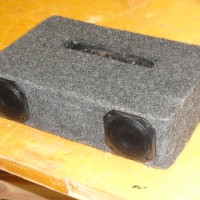
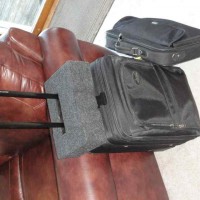
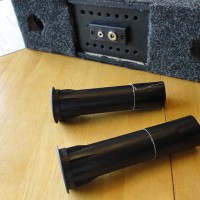
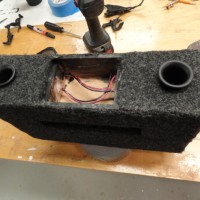
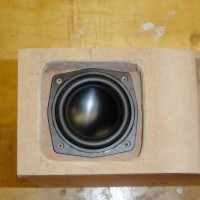
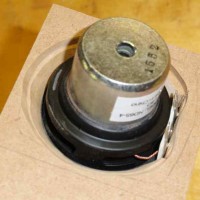
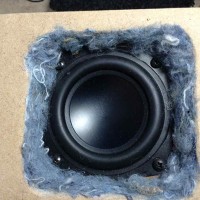
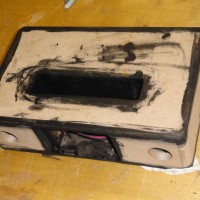
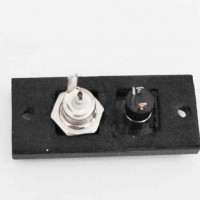
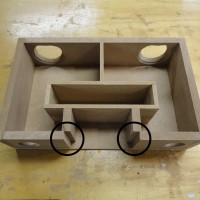
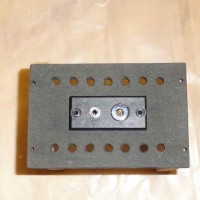

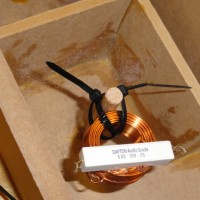
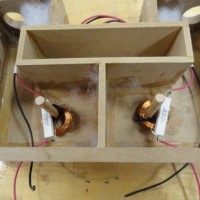
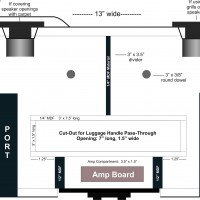
Just a thought. Have you had any issues with TSA or nosey agents questioning the speaker internals?
I haven’t taken this on an airplane as we don’t fly much. I am curious as to if they would allow this as a carry on or not. Good question.